2007 CHEVROLET AVEO seats
[x] Cancel search: seatsPage 83 of 436

Adding Equipment to Your
Airbag-Equipped Vehicle
Q:Is there anything I might add to the
exterior of the vehicle that could keep the
airbags from working properly?
A:Yes. If you add things that change your
vehicle’s frame, bumper system, height,
front end or side sheet metal, they may keep
the airbag system from working properly.
Also, the airbag system may not work properly
if you relocate any of the airbag sensors. If
you have any questions about this, you should
contact Customer Assistance before you
modify your vehicle. The phone numbers and
addresses for Customer Assistance are in
Step Two of the Customer Satisfaction
Procedure in this manual. SeeCustomer
Satisfaction Procedure on page 402.
Q:Because I have a disability, I have to get
my vehicle modi�ed. How can I �nd out
whether this will affect my airbag system?
A:Changing or moving any parts of the
front seats, safety belts, the airbag sensing
and diagnostic module, steering wheel,
instrument panel, or airbag wiring can affect
the operation of the airbag system. If you have
questions, call Customer Assistance. The
phone numbers and addresses for Customer
Assistance are in Step Two of the Customer
Satisfaction Procedure in this manual.
SeeCustomer Satisfaction Procedure on
page 402.
Your dealer/retailer and the service manual have
information about the location of the airbag
sensors, sensing and diagnostic module and
airbag wiring.
83
Page 112 of 436
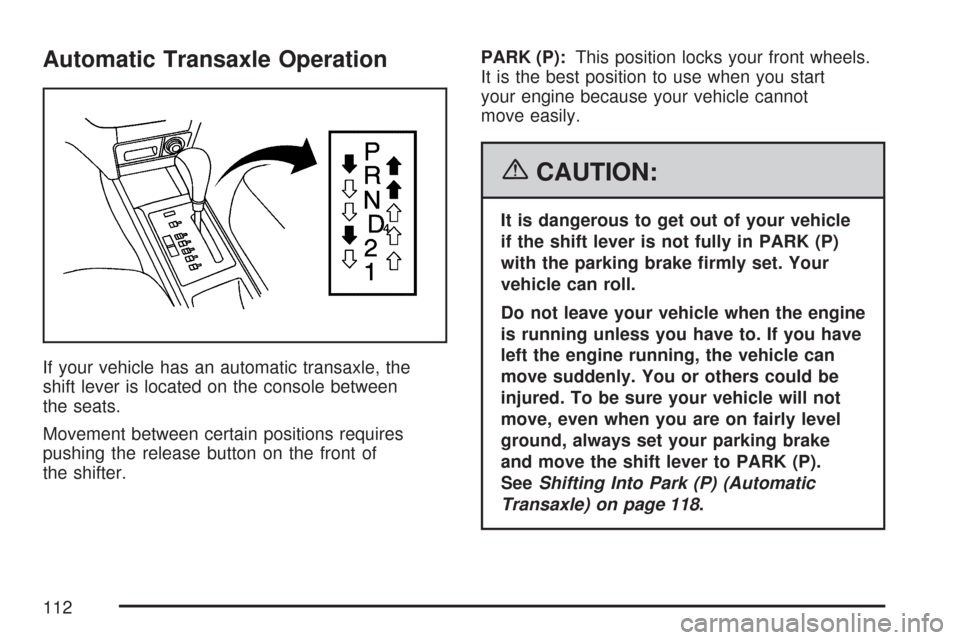
Automatic Transaxle Operation
If your vehicle has an automatic transaxle, the
shift lever is located on the console between
the seats.
Movement between certain positions requires
pushing the release button on the front of
the shifter.PARK (P):This position locks your front wheels.
It is the best position to use when you start
your engine because your vehicle cannot
move easily.
{CAUTION:
It is dangerous to get out of your vehicle
if the shift lever is not fully in PARK (P)
with the parking brake �rmly set. Your
vehicle can roll.
Do not leave your vehicle when the engine
is running unless you have to. If you have
left the engine running, the vehicle can
move suddenly. You or others could be
injured. To be sure your vehicle will not
move, even when you are on fairly level
ground, always set your parking brake
and move the shift lever to PARK (P).
SeeShifting Into Park (P) (Automatic
Transaxle) on page 118.
112
Page 117 of 436
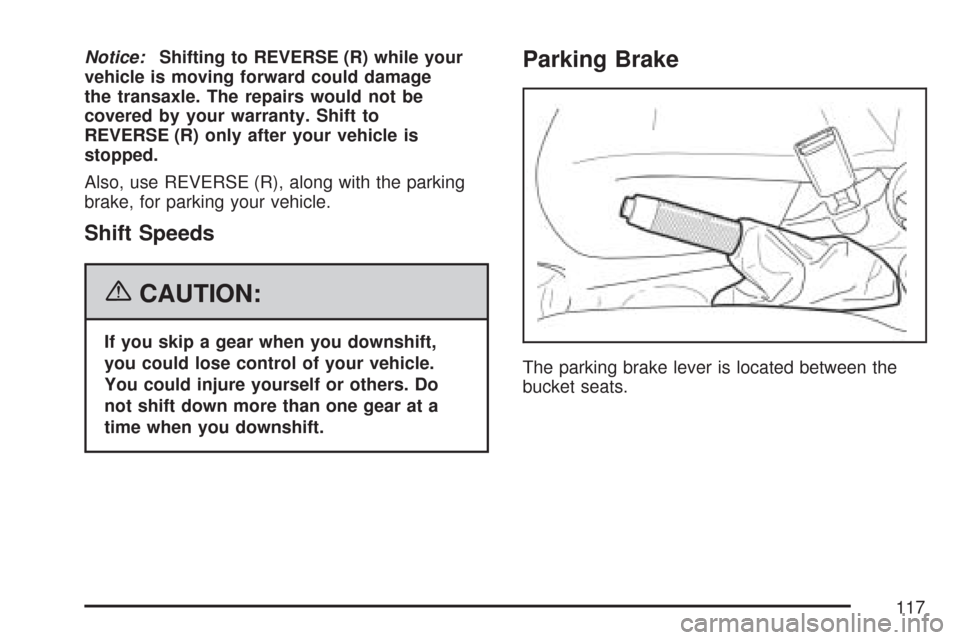
Notice:Shifting to REVERSE (R) while your
vehicle is moving forward could damage
the transaxle. The repairs would not be
covered by your warranty. Shift to
REVERSE (R) only after your vehicle is
stopped.
Also, use REVERSE (R), along with the parking
brake, for parking your vehicle.
Shift Speeds
{CAUTION:
If you skip a gear when you downshift,
you could lose control of your vehicle.
You could injure yourself or others. Do
not shift down more than one gear at a
time when you downshift.
Parking Brake
The parking brake lever is located between the
bucket seats.
117
Page 151 of 436
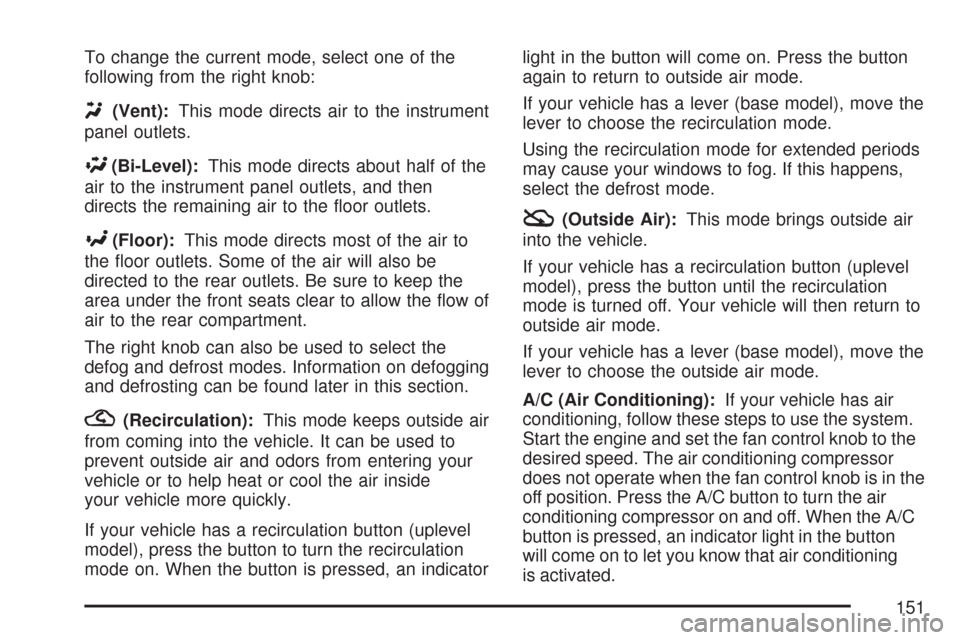
To change the current mode, select one of the
following from the right knob:
Y(Vent):This mode directs air to the instrument
panel outlets.
\(Bi-Level):This mode directs about half of the
air to the instrument panel outlets, and then
directs the remaining air to the floor outlets.
[(Floor):This mode directs most of the air to
the floor outlets. Some of the air will also be
directed to the rear outlets. Be sure to keep the
area under the front seats clear to allow the flow of
air to the rear compartment.
The right knob can also be used to select the
defog and defrost modes. Information on defogging
and defrosting can be found later in this section.
?(Recirculation):This mode keeps outside air
from coming into the vehicle. It can be used to
prevent outside air and odors from entering your
vehicle or to help heat or cool the air inside
your vehicle more quickly.
If your vehicle has a recirculation button (uplevel
model), press the button to turn the recirculation
mode on. When the button is pressed, an indicatorlight in the button will come on. Press the button
again to return to outside air mode.
If your vehicle has a lever (base model), move the
lever to choose the recirculation mode.
Using the recirculation mode for extended periods
may cause your windows to fog. If this happens,
select the defrost mode.
:(Outside Air):This mode brings outside air
into the vehicle.
If your vehicle has a recirculation button (uplevel
model), press the button until the recirculation
mode is turned off. Your vehicle will then return to
outside air mode.
If your vehicle has a lever (base model), move the
lever to choose the outside air mode.
A/C (Air Conditioning):If your vehicle has air
conditioning, follow these steps to use the system.
Start the engine and set the fan control knob to the
desired speed. The air conditioning compressor
does not operate when the fan control knob is in the
off position. Press the A/C button to turn the air
conditioning compressor on and off. When the A/C
button is pressed, an indicator light in the button
will come on to let you know that air conditioning
is activated.
151
Page 154 of 436
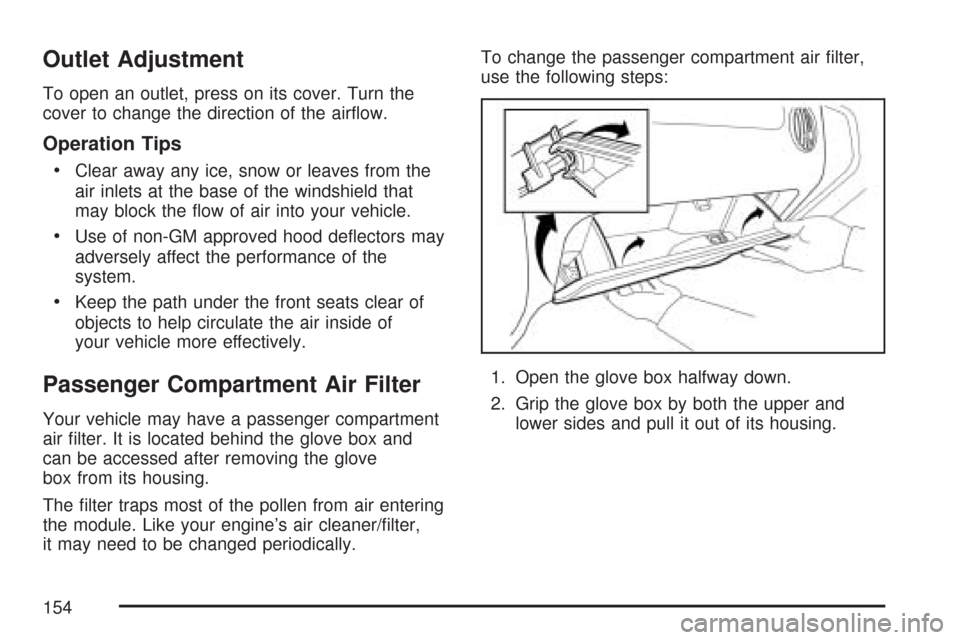
Outlet Adjustment
To open an outlet, press on its cover. Turn the
cover to change the direction of the airflow.
Operation Tips
•
Clear away any ice, snow or leaves from the
air inlets at the base of the windshield that
may block the flow of air into your vehicle.
•Use of non-GM approved hood deflectors may
adversely affect the performance of the
system.
•Keep the path under the front seats clear of
objects to help circulate the air inside of
your vehicle more effectively.
Passenger Compartment Air Filter
Your vehicle may have a passenger compartment
air filter. It is located behind the glove box and
can be accessed after removing the glove
box from its housing.
The filter traps most of the pollen from air entering
the module. Like your engine’s air cleaner/filter,
it may need to be changed periodically.To change the passenger compartment air filter,
use the following steps:
1. Open the glove box halfway down.
2. Grip the glove box by both the upper and
lower sides and pull it out of its housing.
154
Page 257 of 436
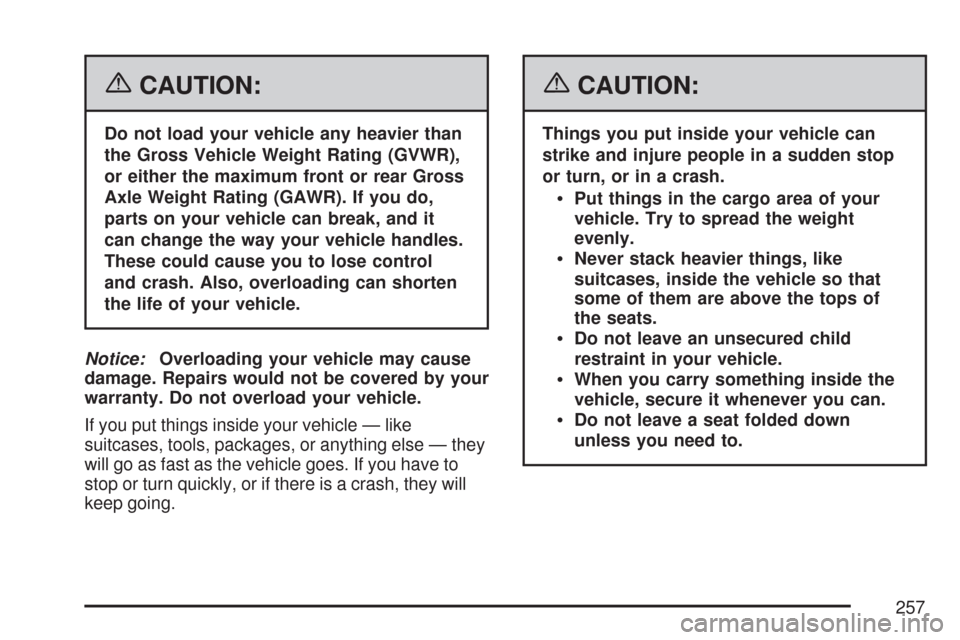
{CAUTION:
Do not load your vehicle any heavier than
the Gross Vehicle Weight Rating (GVWR),
or either the maximum front or rear Gross
Axle Weight Rating (GAWR). If you do,
parts on your vehicle can break, and it
can change the way your vehicle handles.
These could cause you to lose control
and crash. Also, overloading can shorten
the life of your vehicle.
Notice:Overloading your vehicle may cause
damage. Repairs would not be covered by your
warranty. Do not overload your vehicle.
If you put things inside your vehicle — like
suitcases, tools, packages, or anything else — they
will go as fast as the vehicle goes. If you have to
stop or turn quickly, or if there is a crash, they will
keep going.
{CAUTION:
Things you put inside your vehicle can
strike and injure people in a sudden stop
or turn, or in a crash.
Put things in the cargo area of your
vehicle. Try to spread the weight
evenly.
Never stack heavier things, like
suitcases, inside the vehicle so that
some of them are above the tops of
the seats.
Do not leave an unsecured child
restraint in your vehicle.
When you carry something inside the
vehicle, secure it whenever you can.
Do not leave a seat folded down
unless you need to.
257
Page 323 of 436
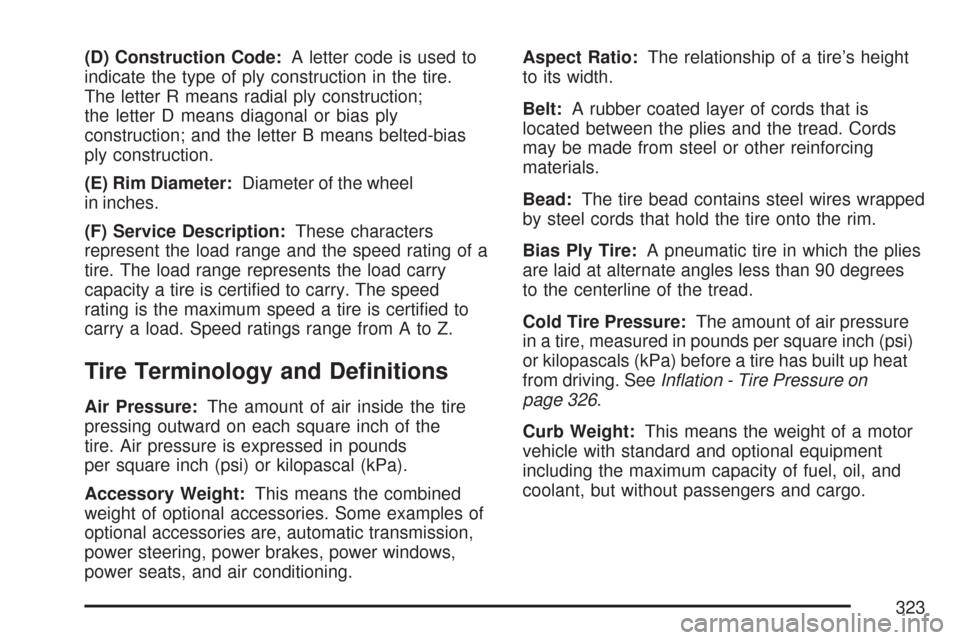
(D) Construction Code:A letter code is used to
indicate the type of ply construction in the tire.
The letter R means radial ply construction;
the letter D means diagonal or bias ply
construction; and the letter B means belted-bias
ply construction.
(E) Rim Diameter:Diameter of the wheel
in inches.
(F) Service Description:These characters
represent the load range and the speed rating of a
tire. The load range represents the load carry
capacity a tire is certified to carry. The speed
rating is the maximum speed a tire is certified to
carry a load. Speed ratings range from A to Z.
Tire Terminology and De�nitions
Air Pressure:The amount of air inside the tire
pressing outward on each square inch of the
tire. Air pressure is expressed in pounds
per square inch (psi) or kilopascal (kPa).
Accessory Weight:This means the combined
weight of optional accessories. Some examples of
optional accessories are, automatic transmission,
power steering, power brakes, power windows,
power seats, and air conditioning.Aspect Ratio:The relationship of a tire’s height
to its width.
Belt:A rubber coated layer of cords that is
located between the plies and the tread. Cords
may be made from steel or other reinforcing
materials.
Bead:The tire bead contains steel wires wrapped
by steel cords that hold the tire onto the rim.
Bias Ply Tire:A pneumatic tire in which the plies
are laid at alternate angles less than 90 degrees
to the centerline of the tread.
Cold Tire Pressure:The amount of air pressure
in a tire, measured in pounds per square inch (psi)
or kilopascals (kPa) before a tire has built up heat
from driving. SeeInflation - Tire Pressure on
page 326.
Curb Weight:This means the weight of a motor
vehicle with standard and optional equipment
including the maximum capacity of fuel, oil, and
coolant, but without passengers and cargo.
323
Page 431 of 436

Maintenance Schedule (cont.)
Steering, Suspension and Front Drive
Axle Boot and Seal Inspection.............. 394
Using....................................................... 374
Your Vehicle and the Environment............ 372
Malfunction Indicator Light..................166, 180
Manual Lumbar Controls................................. 9
Manual Seats.................................................. 8
Manual Transaxle
Fluid........................................................ 285
Operation................................................. 116
Manual Windows......................................... 101
Mirrors
Manual Rearview Mirror........................... 124
Outside Convex Mirror............................. 126
Outside Heated Mirrors............................ 126
Outside Manual Mirrors............................ 124
Outside Power Mirror............................... 125
MP3 ...................................................207, 211
MyGMLink.com............................................ 405
N
New Vehicle Break-In.................................. 107
Normal Maintenance Replacement Parts..... 369
O
Odometer.................................................... 159
Odometer, Trip............................................ 159
Off-Road Recovery...................................... 230
Oil
Engine..................................................... 277
Pressure Light.................................169, 184
Older Children, Restraints............................. 41
Online Owner Center................................... 405
Other Warning Devices................................ 136
Outlet Adjustment........................................ 154
Outlets
Accessory Power..................................... 147
Outside
Convex Mirror.......................................... 126
Heated Mirrors......................................... 126
Manual Mirrors......................................... 124
Power Mirror............................................ 125
Owners, Canadian.......................................... 3
431